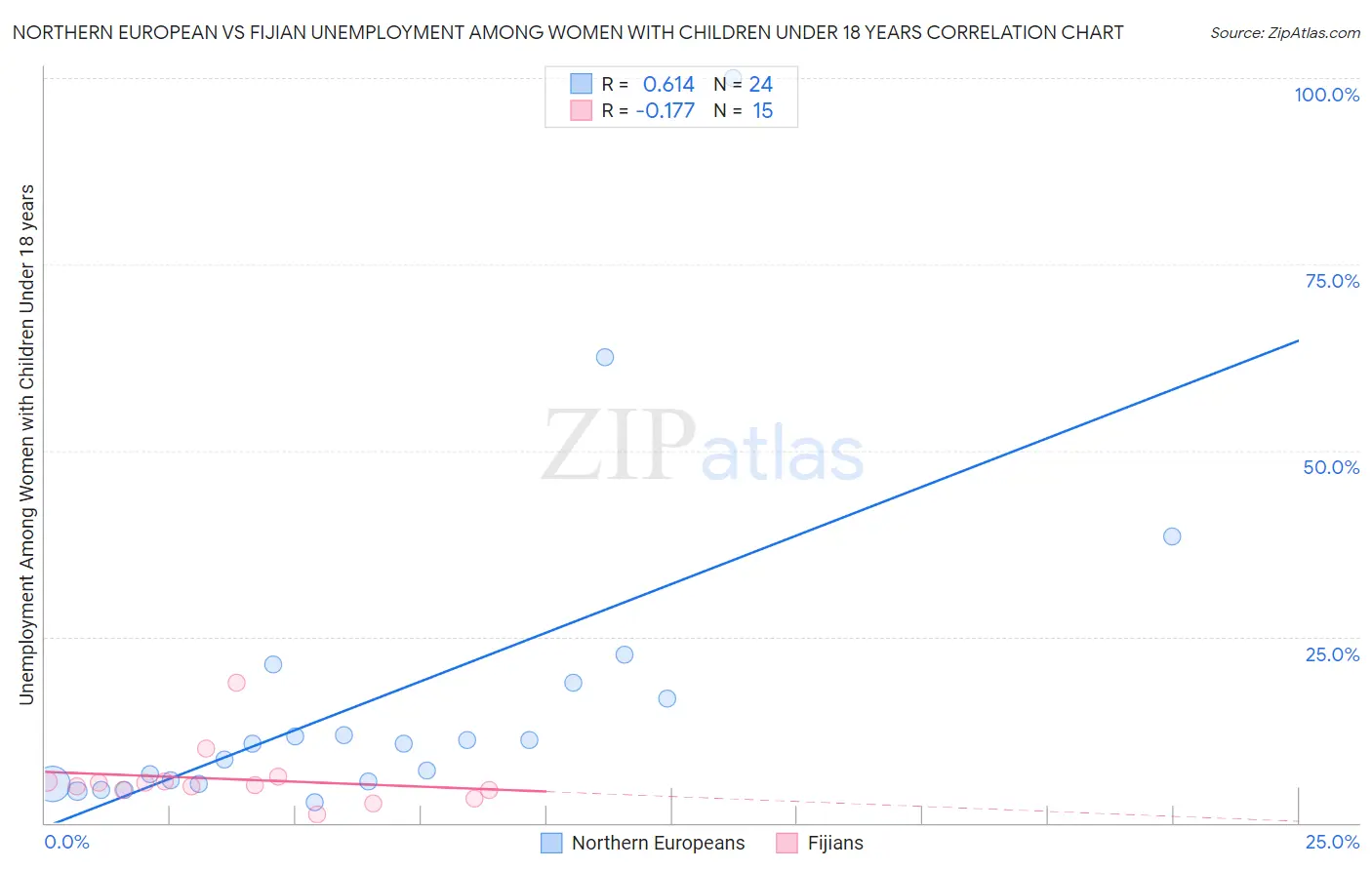Northern European vs Fijian Unemployment Among Women with Children Under 18 years
COMPARE
Northern European
Fijian
Unemployment Among Women with Children Under 18 years
Unemployment Among Women with Children Under 18 years Comparison
Northern Europeans
Fijians
5.0%
UNEMPLOYMENT AMONG WOMEN WITH CHILDREN UNDER 18 YEARS
98.6/ 100
METRIC RATING
48th/ 347
METRIC RANK
5.1%
UNEMPLOYMENT AMONG WOMEN WITH CHILDREN UNDER 18 YEARS
96.9/ 100
METRIC RATING
67th/ 347
METRIC RANK
Northern European vs Fijian Unemployment Among Women with Children Under 18 years Correlation Chart
The statistical analysis conducted on geographies consisting of 384,114,804 people shows a significant positive correlation between the proportion of Northern Europeans and unemployment rate among women with children under the age of 18 in the United States with a correlation coefficient (R) of 0.614 and weighted average of 5.0%. Similarly, the statistical analysis conducted on geographies consisting of 55,417,162 people shows a poor negative correlation between the proportion of Fijians and unemployment rate among women with children under the age of 18 in the United States with a correlation coefficient (R) of -0.177 and weighted average of 5.1%, a difference of 1.5%.

Unemployment Among Women with Children Under 18 years Correlation Summary
| Measurement | Northern European | Fijian |
| Minimum | 2.7% | 1.2% |
| Maximum | 100.0% | 18.8% |
| Range | 97.3% | 17.6% |
| Mean | 17.0% | 5.9% |
| Median | 10.7% | 5.0% |
| Interquartile 25% (IQ1) | 5.4% | 4.4% |
| Interquartile 75% (IQ3) | 17.7% | 5.6% |
| Interquartile Range (IQR) | 12.3% | 1.2% |
| Standard Deviation (Sample) | 22.0% | 4.1% |
| Standard Deviation (Population) | 21.6% | 3.9% |
Demographics Similar to Northern Europeans and Fijians by Unemployment Among Women with Children Under 18 years
In terms of unemployment among women with children under 18 years, the demographic groups most similar to Northern Europeans are British (5.0%, a difference of 0.13%), Lithuanian (5.0%, a difference of 0.22%), Immigrants from Japan (5.0%, a difference of 0.25%), Yugoslavian (5.1%, a difference of 0.33%), and Immigrants from Nepal (5.1%, a difference of 0.33%). Similarly, the demographic groups most similar to Fijians are Immigrants from Australia (5.1%, a difference of 0.020%), Immigrants from Sweden (5.1%, a difference of 0.12%), Estonian (5.1%, a difference of 0.14%), Italian (5.1%, a difference of 0.31%), and Immigrants from Bulgaria (5.1%, a difference of 0.33%).
| Demographics | Rating | Rank | Unemployment Among Women with Children Under 18 years |
| British | 98.7 /100 | #47 | Exceptional 5.0% |
| Northern Europeans | 98.6 /100 | #48 | Exceptional 5.0% |
| Lithuanians | 98.4 /100 | #49 | Exceptional 5.0% |
| Immigrants | Japan | 98.4 /100 | #50 | Exceptional 5.0% |
| Yugoslavians | 98.3 /100 | #51 | Exceptional 5.1% |
| Immigrants | Nepal | 98.3 /100 | #52 | Exceptional 5.1% |
| Scottish | 98.2 /100 | #53 | Exceptional 5.1% |
| Immigrants | Serbia | 98.2 /100 | #54 | Exceptional 5.1% |
| Immigrants | Sri Lanka | 98.1 /100 | #55 | Exceptional 5.1% |
| Immigrants | Ireland | 98.0 /100 | #56 | Exceptional 5.1% |
| Czechoslovakians | 98.0 /100 | #57 | Exceptional 5.1% |
| Immigrants | Belgium | 97.9 /100 | #58 | Exceptional 5.1% |
| Asians | 97.9 /100 | #59 | Exceptional 5.1% |
| Welsh | 97.7 /100 | #60 | Exceptional 5.1% |
| Russians | 97.5 /100 | #61 | Exceptional 5.1% |
| Immigrants | Bulgaria | 97.4 /100 | #62 | Exceptional 5.1% |
| Italians | 97.4 /100 | #63 | Exceptional 5.1% |
| Estonians | 97.2 /100 | #64 | Exceptional 5.1% |
| Immigrants | Sweden | 97.1 /100 | #65 | Exceptional 5.1% |
| Immigrants | Australia | 97.0 /100 | #66 | Exceptional 5.1% |
| Fijians | 96.9 /100 | #67 | Exceptional 5.1% |